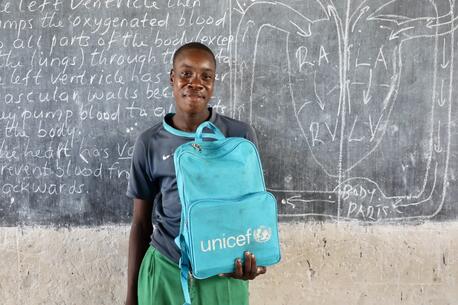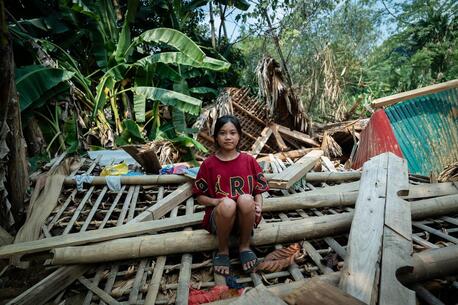
COP26 Update: UNICEF Rallies Businesses Behind Climate Action
A top priority for UNICEF at last week's climate summit was to get businesses to acknowledge that child rights and the environment are interconnected — and to drive deeper commitments to addressing and mitigating the negative effects of climate change on children's lives. A look at UNICEF's 10-point plan for leveraging the power of the private sector behind climate action.
UNICEF has long viewed the private sector as a critical partner in advancing progress for children on a range of global issues — and climate change is no different.
To drive that point home, UNICEF worked to rally business leaders at COP26 to commit to putting child rights at the heart of climate action.
An expression of that commitment was included in a statement issued during a climate summit side event co-hosted by UNICEF and the International Chamber of Commerce. The statement, endorsed by the World Business Council for Sustainable Development and others, commits signatories to set ambitious emissions reduction targets, shift to renewable energy sources and adopt other environmentally-friendly business practices. It also calls on governments to provide urgent climate action funding and fulfill their commitments under the Paris Agreement with an end goal to reach ‘net zero’ emissions by 2050.
“We are calling on captains of industry to work with us in co-creating solutions towards a green economy without delay, so that our children and future generations can inherit a liveable planet,” said Carla Haddad Mardini, UNICEF’s Director of Private Sector Partnerships.

Kids take part in a Fridays for Future demonstration for climate action led by youth climate activists and organized on the sidelines of the 2021 UN Climate Change Conference (COP26). Some 25,000 protesters gathered to lend their voices to calls for stronger commitments by governments to take concrete and corrective action to avert catastrophic climate change. © UNICEF/UN0547114/Elwyn-Jones
The move follows the release of a UNICEF study that found that barely one-third of national climate policies were "child sensitive." For the study, UNICEF examined Nationally Determined Contributions – or NDCs – submitted by countries that signed the Paris Agreement, reviewing 103 country plans.
"Only 1 in 5 [country plans] reference child rights or intergenerational justice and equity in a meaningful way," Gautam Narasimhan, UNICEF Global Lead for Climate, Energy and Environment said. Only 12 percent report that children participated in the development of the plan, he added.
"Countries are saying the right things about considering and including children but their climate plans leave their promises hollow," Narasimhan said. "Children and young people bring energy, leadership and ideas to the table and yet leaders continue to pay lip service to their demands."

A young climate activist makes her point in Glasgow during COP26. By the end of the UN climate conference, negotiators had reached an agreement — one that calls on governments to return next year with stronger plans to keep global warming below 1.5 degrees Celsius and urges wealthy countries to “at least double” funding by 2025 to protect countries that are most vulnerable to climate change impacts. © UNICEF/UN0547115/Elwyn-Jones
For UNICEF, addressing and mitigating climate change impacts is about upholding the rights of children to live in clean, safe, healthy environments. But how businesses go about it could also violate children's rights or have other negative effects, UNICEF experts warn.
"There are well-known risks associated with the minerals necessary for the green transition — cobalt, for example," explained Maria Pia Bianchetti, a UNICEF expert on child rights and business in a video posted on Twitter and elsewhere. "The green transition also risks pushing children into poverty, and increasing the risks of child labor among children who are displaced by climate change impacts, she added.
A 10-point plan for driving climate action
"While businesses have contributed to climate change, they can and should be part of the solution," Bianchetti said. "What we ask businesses to do is to ... ensure that mitigation and adaptation efforts do not infringe on human and child rights and to advocate for their peers to do the same."
UNICEF offers 10 ways businesses can help make it happen:
- Include young people in all climate negotiations and decisions
- Invest in climate adaptation and resilience in key services for children
- Fund innovations to address the effects of climate change on children
- Support children with climate education and green skills
- Drastically reduce emissions by at least 45 percent from 2021 level by 2030
- Ensure the recovery from the COVID-19 pandemic is green, low-carbon and inclusive
- Consider children's needs and interests when considering corporate social responsibility (ESG) initiatives
- Join efforts with stakeholders to respond to climate-related emergencies
- Advocate for governments to develop and enhance policies that promote climate action
- Donate to UNICEF’s Safe and Healthy Environment Fund
During one panel discussion, part of the Make Climate Action Everyone's Business Forum, businesses leaders emphasized the need for industry to scale investments in social infrastructure to ensure that schools, health centers, water and sanitation and critical systems can withstand climate shocks.

The success of the deal reached at COP26 "will hinge on whether world leaders now follow through with new policies to cut greenhouse gas emissions," The New York Times reported. "And the deal still leaves vulnerable countries far short of the funds they need to cope with increasing weather disasters." © UNICEF/UN0547132/Elwyn-Jones
In one exchange, UNICEF spokesperson James Elder, acting as panel moderator, asked Charlotte Petri Gornitzka, UNICEF Deputy Executive Director, how businesses could best contribute. "What solutions do you see that are aiming to protect kids and their communities from this crisis —and how do businesses scale them up so they get to a level that is actually meaningful?" Elder asked.
"The long-term solution is reduction in emissions — and of course business needs to be there — but there is no excuse not to be much more at the table when it comes to adaptation," Gornitzka responded. "And that’s where we need to remind ourselves that children are at risk and it’s happening now. So we cannot just wait for the long term, we have to act now."
There's a lot that industry can do across critical sectors such as education, health and water — to make sure the infrastructure is resilient to climate change and to prevent disruptions in essential services, Gornitzka continued. But they need to think big. "We don’t need businesses to look good by investing in small projects and writing about them in their annual report," she said. "We need them to use their core business, to use knowledge from pilot projects that we know work and bring them to scale. Business is all about that. They can teach how to go to scale."
Taking responsibility for the consequences of business actions — good and bad
Businesses need to look at the "whole value chain" and take responsibility for the consequences of rising demand for minerals associated with child labor, she added.
Meghna Das, a UNICEF senior program specialist on sustainability, voiced similar views in a separate communication. "Climate change is an interconnected problem which requires interconnected solutions across the life cycle of a child, from immediate emergency response to long-term, sustainable development and low-carbon development, as well as climate-resilient services for children — climate-smart schools, health facilities, WASH facilities," she said in a video address.
"We need everyone to help us address this urgent climate crisis for children, from government partners to private sector partners, teachers, parents, students, children, young people — everyone. Join us."
Learn more about how UNICEF and UNICEF USA work with the business community to advance child rights.
Watch the video of the Nov. 9 session of the COP26 UNICEF and ICC side event moderated by UNICEF spokesperson James Elder. Review and sign the Business Statement on Children and Climate Changehere.
Top photo: A child in Jonglei State, South Sudan, where already vulnerable families are suffering the compounded effects of multi-year flooding related to climate change — a striking example of how changing weather patterns are affecting where people can live, where food can grow and where societies can exist. Everything In Jonglei has been disrupted, from the economy to health to education, Lynsey Addario writes in her coverage for National Geographic. UNICEF is on the ground treating severely malnourished children and providing emergency health care amid rising cases of malaria, diarrhea and other diseases. Supplies have to be carried into affected areas on foot. Yves Willemot, chief of communication for UNICEF in South Sudan: "South Sudanese are paying the price for something that they are very much the very last ones to be responsible for." © UNICEF/UN0475188/
HOW TO HELP
There are many ways to make a difference
War, famine, poverty, natural disasters — threats to the world's children keep coming. But UNICEF won't stop working to keep children healthy and safe.
UNICEF works in over 190 countries and territories — more places than any other children's organization. UNICEF has the world's largest humanitarian warehouse and, when disaster strikes, can get supplies almost anywhere within 72 hours. Constantly innovating, always advocating for a better world for children, UNICEF works to ensure that every child can grow up healthy, educated, protected and respected.
Would you like to help give all children the opportunity to reach their full potential? There are many ways to get involved.




